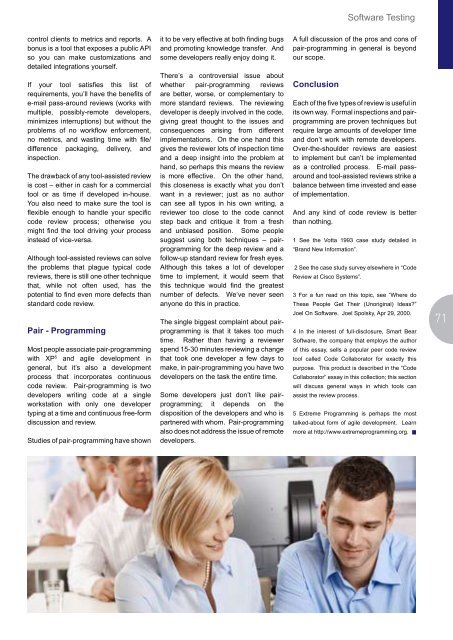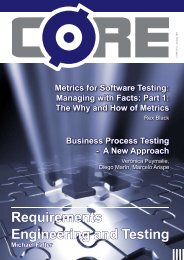Comparison of Change Management Systems
Comparison of Change Management Systems
Comparison of Change Management Systems
Create successful ePaper yourself
Turn your PDF publications into a flip-book with our unique Google optimized e-Paper software.
control clients to metrics and reports. A<br />
bonus is a tool that exposes a public API<br />
so you can make customizations and<br />
detailed integrations yourself.<br />
If your tool satisfies this list <strong>of</strong><br />
requirements, you’ll have the benefits <strong>of</strong><br />
e-mail pass-around reviews (works with<br />
multiple, possibly-remote developers,<br />
minimizes interruptions) but without the<br />
problems <strong>of</strong> no workflow enforcement,<br />
no metrics, and wasting time with file/<br />
difference packaging, delivery, and<br />
inspection.<br />
The drawback <strong>of</strong> any tool-assisted review<br />
is cost – either in cash for a commercial<br />
tool or as time if developed in-house.<br />
You also need to make sure the tool is<br />
flexible enough to handle your specific<br />
code review process; otherwise you<br />
might find the tool driving your process<br />
instead <strong>of</strong> vice-versa.<br />
Although tool-assisted reviews can solve<br />
the problems that plague typical code<br />
reviews, there is still one other technique<br />
that, while not <strong>of</strong>ten used, has the<br />
potential to find even more defects than<br />
standard code review.<br />
Pair - Programming<br />
Most people associate pair-programming<br />
with XP 5 and agile development in<br />
general, but it’s also a development<br />
process that incorporates continuous<br />
code review. Pair-programming is two<br />
developers writing code at a single<br />
workstation with only one developer<br />
typing at a time and continuous free-form<br />
discussion and review.<br />
Studies <strong>of</strong> pair-programming have shown<br />
it to be very effective at both finding bugs<br />
and promoting knowledge transfer. And<br />
some developers really enjoy doing it.<br />
There’s a controversial issue about<br />
whether pair-programming reviews<br />
are better, worse, or complementary to<br />
more standard reviews. The reviewing<br />
developer is deeply involved in the code,<br />
giving great thought to the issues and<br />
consequences arising from different<br />
implementations. On the one hand this<br />
gives the reviewer lots <strong>of</strong> inspection time<br />
and a deep insight into the problem at<br />
hand, so perhaps this means the review<br />
is more effective. On the other hand,<br />
this closeness is exactly what you don’t<br />
want in a reviewer; just as no author<br />
can see all typos in his own writing, a<br />
reviewer too close to the code cannot<br />
step back and critique it from a fresh<br />
and unbiased position. Some people<br />
suggest using both techniques – pairprogramming<br />
for the deep review and a<br />
follow-up standard review for fresh eyes.<br />
Although this takes a lot <strong>of</strong> developer<br />
time to implement, it would seem that<br />
this technique would find the greatest<br />
number <strong>of</strong> defects. We’ve never seen<br />
anyone do this in practice.<br />
The single biggest complaint about pairprogramming<br />
is that it takes too much<br />
time. Rather than having a reviewer<br />
spend 15-30 minutes reviewing a change<br />
that took one developer a few days to<br />
make, in pair-programming you have two<br />
developers on the task the entire time.<br />
Some developers just don’t like pairprogramming;<br />
it depends on the<br />
disposition <strong>of</strong> the developers and who is<br />
partnered with whom. Pair-programming<br />
also does not address the issue <strong>of</strong> remote<br />
developers.<br />
S<strong>of</strong>tware Testing<br />
A full discussion <strong>of</strong> the pros and cons <strong>of</strong><br />
pair-programming in general is beyond<br />
our scope.<br />
Conclusion<br />
Each <strong>of</strong> the five types <strong>of</strong> review is useful in<br />
its own way. Formal inspections and pairprogramming<br />
are proven techniques but<br />
require large amounts <strong>of</strong> developer time<br />
and don’t work with remote developers.<br />
Over-the-shoulder reviews are easiest<br />
to implement but can’t be implemented<br />
as a controlled process. E-mail passaround<br />
and tool-assisted reviews strike a<br />
balance between time invested and ease<br />
<strong>of</strong> implementation.<br />
And any kind <strong>of</strong> code review is better<br />
than nothing.<br />
1 See the Votta 1993 case study detailed in<br />
“Brand New Information”.<br />
2 See the case study survey elsewhere in “Code<br />
Review at Cisco <strong>Systems</strong>”.<br />
3 For a fun read on this topic, see “Where do<br />
These People Get Their (Unoriginal) Ideas?”<br />
Joel On S<strong>of</strong>tware. Joel Spolsky, Apr 29, 2000.<br />
4 In the interest <strong>of</strong> full-disclosure, Smart Bear<br />
S<strong>of</strong>tware, the company that employs the author<br />
<strong>of</strong> this essay, sells a popular peer code review<br />
tool called Code Collaborator for exactly this<br />
purpose. This product is described in the “Code<br />
Collaborator” essay in this collection; this section<br />
will discuss general ways in which tools can<br />
assist the review process.<br />
5 Extreme Programming is perhaps the most<br />
talked-about form <strong>of</strong> agile development. Learn<br />
more at http://www.extremeprogramming.org.<br />
71



